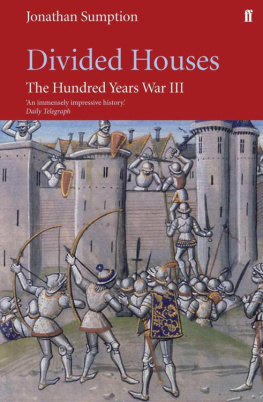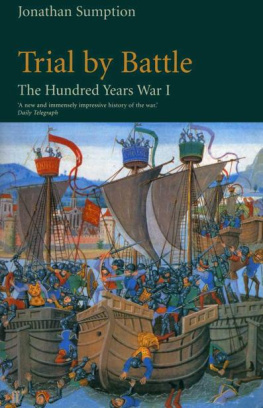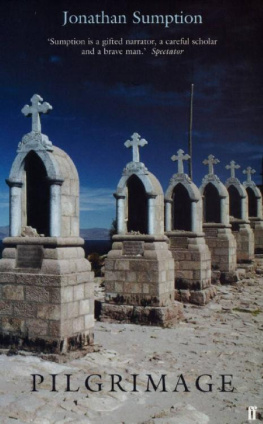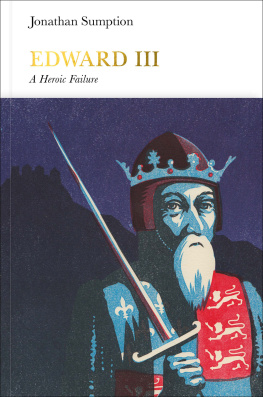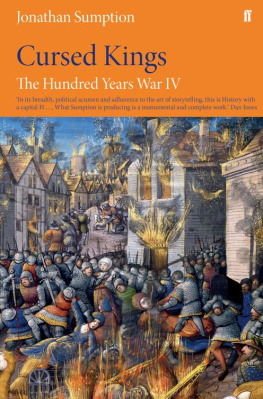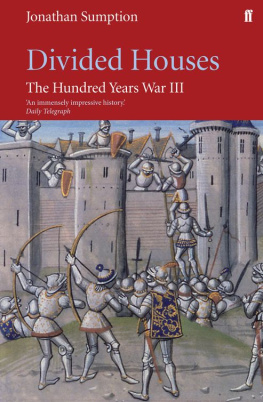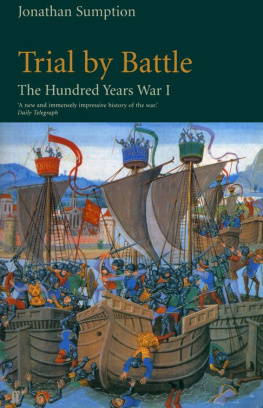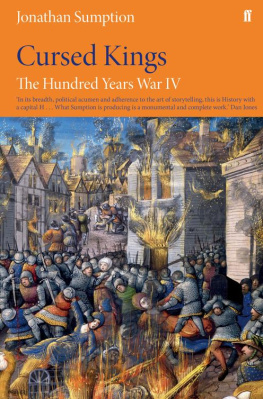THE HUNDRED YEARS WAR
JONATHAN SUMPTION
VOLUME III
Divided Houses
To Jude
Contents
Maps, Plans and Tables
In the text
General maps
Family trees
Preface
There are few darker periods of Englands history than the last three decades of the fourteenth century. The famous victories of Edward III and the Black Prince had set standards of achievement which their successors could never hope to match. The one-sided treaty of Brtigny which followed them had embodied Englands territorial claims at their grandest and most ambitious, drawing lines across the map of France from which another generation of English diplomats was unable to retreat with honour. Prisoners of their own triumphs, the English were condemned to see the conquests of the past thirty years overrun by the armies of the King of France in less than ten. Edward himself, a senile, pathetic symbol, outlived all the companions of his great years, and finally his son the Black Prince as well. Rarely has nemesis followed so quickly and directly upon hubris . When Edward died in 1377, he was succeeded by a vulnerable child, who was destined to grow into a neurotic and unstable adult presiding over a divided nation, until he was finally deposed and murdered by his cousin.
Although these were years of defeat for England, they were not sterile years. The conduct of the war passed into the hands of the growing class of career soldiers and adventurers. Their leaders were men of courage, determination and strategic imagination, who ensured that England remained an effective belligerent even against the background of financial penury and persistent retreat. Great maritime bases were established on the Atlantic coast of France from Calais to Bayonne. English war fleets operated from Dordrecht to Lisbon. English armies operated not only in France but in Flanders, Portugal, Navarre and Castile, and as free companies in Italy and Germany. English diplomats were active in every European country. Yet all this effort was destined to end in failure. For in the fourteenth century, as in almost all periods, the chief material of war was money. England was among the most intensively governed states of contemporary Europe, but it lacked the resources to fight an aggressive war of conquest against a country with three times its wealth and population. For much of this period England also had to take on Castile, the principal naval power of the Atlantic seaboard; Flanders, still the greatest industrial and commercial power of Europe outside Italy; and Scotland, a constant menace in her rear.
However, France too paid a heavy price for her success. On the surface, these were glittering years for France: years of extravagant ceremony at the grandest court of Europe, of great palaces, of famous paladins making their reputations as far afield as Naples, Hungary, Poland and Constantinople, of astonishing artistic creativity among painters, sculptors, jewellers, poets and novelists. Yet beneath the surface the French government lived constantly at the edge of bankruptcy and the population subsisted in fear and insecurity. Large parts of the country, especially in the south, were ruined and depopulated by the burden of war taxation. In the wealthier northern provinces around the capital there were co-ordinated movements of rebellion and social revolution. These pressures would have been difficult for any government to contain. But the inexperience of Charles VI and his gradual relapse into insanity after 1392 divided the French political world, as the Kings relatives competed for the plunder of the state, sowing the seeds of disintegration and civil war in the following century. Like England in the dotage of Edward III, France was destined to destroy herself by the completeness of her victory.
The late fourteenth century was above all a self-conscious age. Its achievements and failings were remorselessly analysed by the chroniclers, lawyers, social commentators and poets of the time. From Chaucer and Gower in England to Eustache Deschamps and Christine de Pisan in France, contemporary writers were convinced that they were living through fascinating times: times of great wickedness and great achievement, of intense personal heroism and collective mediocrity, of extremes of wealth and poverty, fortune and failure. More than six centuries later, it is possible to agree with all of these judgments. It is also possible to reconstruct the mood of the time with the aid of a range of narrative, literary and record sources far wider than those available for any earlier period of medieval history, and drawn from the whole of western and southern Europe. I have made use of all of this material. But the narrative is shaped mainly by the extensive record sources of England, France and Spain. In this and other respects, the principles on which this history is written were explained in the preface to the first volume, and have not changed.
I should like to thank Sir William Harding for making many helpful suggestions about the text, and saving me from countless solecisms.
J.P.C.S.
Greenwich
February 2008
Synopsis to 1369
After three decades in which the ambiguous status of the duchy of Aquitaine had poisoned relations between England and France, Philip VI of France decreed the confiscation of the duchy in 1337 and Edward III declared war. Edwards initial strategy was to stir up the internal political tensions of France, encouraging rebellions against the authority of the French Crown with promises of military support. Between 1338 and 1340, the English King concentrated his efforts on Flanders where the revolt of the towns against their count, Louis of Nevers, provided him with a rich and powerful ally on Frances northernmost province. To provide the Flemings with a justification for making war on Philip VI and to encourage other provincial rebellions, Edward revived the claim which he had made at the beginning of his reign to be the rightful king of France through his mother (the eldest daughter of Philip IV of France). In 1340 he proclaimed himself King of France at Ghent. But apart from the famous sea-battle at Sluys in 1340, which resulted in the destruction of the French fleet, Edward IIIs northern strategy was a failure which ended in military stalemate and bankruptcy.
The English King turned next to Brittany, where a war of succession broke out in 1341 between the house of Montfort, backed by England, and the French Kings candidate, Charles of Blois. Strategically, this was more productive. The English occupied much of Brittany, including the important coastal fortress of Brest. Finally, in 1346, Edward III landed in Normandy with a large English army to take advantage of an incipient rebellion among sections of the Norman nobility. The rebellion never materialised, but Edward marched through northern France and, confronted by the numerically superior army of Philip VI north of the Somme, defeated and largely destroyed it at the battle of Crcy. He went on to capture Calais in 1347 after a siege of eleven months. These events coincided with important developments in other theatres. In England, an attempt by Frances long-standing Scottish ally to mount a diversion in Edwards rear ended with their defeat at Nevilles Cross in 1346 and the capture of the King of Scotland, David II. Henry of Lancaster took an army to Bordeaux in 1345, and over a period of some eighteen months recovered much of the territory in the lower valleys of the Garonne and the Dordogne which had been lost to the French in the early years of the war.
The following decade was dominated by the attempts of Edward III and the Prince of Wales to exploit the prolonged and destructive rebellion of Charles of Evreux (the Bad), King of Navarre, which began with the assassination of the Constable of France, Charles of Spain, in 1354. In 1356, John II of France arrested Charles in Rouen castle, and put a number of his principal supporters to death. These events provoked the greatest civil war in Frances medieval history. As France subsided into anarchy, the English planned co-ordinated invasions of northern France by three English armies operating from Calais, Brittany and Aquitaine. The only part of this ambitious plan to be carried through to a conclusion was the southern invasion, which was conducted by the Prince of Wales with a combined English and Gascon army from Bordeaux. John II marched against the Prince, and caught up with him east of Poitiers in September 1356. The battle of Poitiers ended with the loss of Johns army and his own capture. It also led to four years of civil war in the course of which Paris was taken over by a revolutionary regime led by Charles of Navarre and the demagogue tienne Marcel. Much of northern France was occupied by English garrisons, Navarrese armies, and German, English and Gascon free companies. This disastrous period in French history was brought to an end by the treaties of Brtigny (1360) and Calais (1361). By these treaties, John II obtained his own release and Edward IIIs promise to abandon his pretension to be King of France. But in return he had to promise a crushing ransom and to cede about a quarter of the territory of his kingdom to create an enlarged duchy of Aquitaine, free of all feudal dependence on France. In 1363, the duchy became an independent principality, which was settled on the Prince of Wales.

